Report from Tallahassee by Colette Copeland
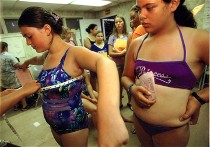 After two weeks of rain in Philly, I jumped at the chance to head south for some power, sex and sun. Power: Sex, Politics & the Pursuit of Global Domination was the theme of this year’s Southeast Society for Photographic Education’s conference held in Tallahassee, Fla., Oct. 14 to 16 (image from Lauren Greenfield’s “Girl Culture–Fat Camp in the Catskills”).
After two weeks of rain in Philly, I jumped at the chance to head south for some power, sex and sun. Power: Sex, Politics & the Pursuit of Global Domination was the theme of this year’s Southeast Society for Photographic Education’s conference held in Tallahassee, Fla., Oct. 14 to 16 (image from Lauren Greenfield’s “Girl Culture–Fat Camp in the Catskills”)..
Co-chairs Daniel Kariko and Scott Groeniger, both professors at Florida State University (the host site), chose big-name artists whose work explores power as manifested in the images, signs and symbols of contemporary culture.
The presentations reminded me of the profound and daunting quote by Primo Levi, “An artist’s first responsibility is to bear witness.” The featured and invited artists while disparate in their subject matter, materials and intention, exhibit unified vision in their ability to bear witness through their work.
Keynote speaker Lauren Greenfield bears witness to America’s youth culture. Showing documentary photographs from her books, “Girl Culture” and “Fast Forward”, Greenfield spoke about her interest in the rituals of youth. Themes of materialism, consumption, and body image recur in her images, demonstrating the power of money and the media culture to corrupt youth. Greenfield does not assume the voice of authority, but allows her subjects to tell their stories in their own words.
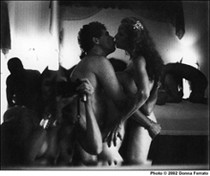 Documentary photographer and activist Donna Ferrato bears witness to hidden aspects of society including domestic violence and the dark side of love—sex clubs, swingers and prostitution. A master storyteller, Ferrato captivated the audience with horrifying tales resulting from photographing victims of domestic violence for more than 25 years. Living in shelters for months at a time, Ferrato developed relationships with many women, who opened up their lives for her to record. Her “Love & Lust” work explores people’s desire to be loved, in a world where violence and sex are used to exert power and control. Ferrato uses her camera to reveal the indomitable spirit within us. She is currently working on a film about the children whose lives were affected by domestic violence (right, orgy self-portrait by Ferrato, 2002).
Documentary photographer and activist Donna Ferrato bears witness to hidden aspects of society including domestic violence and the dark side of love—sex clubs, swingers and prostitution. A master storyteller, Ferrato captivated the audience with horrifying tales resulting from photographing victims of domestic violence for more than 25 years. Living in shelters for months at a time, Ferrato developed relationships with many women, who opened up their lives for her to record. Her “Love & Lust” work explores people’s desire to be loved, in a world where violence and sex are used to exert power and control. Ferrato uses her camera to reveal the indomitable spirit within us. She is currently working on a film about the children whose lives were affected by domestic violence (right, orgy self-portrait by Ferrato, 2002).
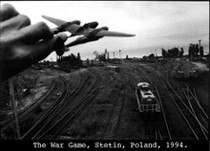 Sylvia de Swann bears witness to the Holocaust by retracing her experiences as a Hungarian refugee during World War II. Investigating issues of memory and displacement, de Swann travels by train over the landscape of her childhood, searching for remnants from the past. Using photography and text, de Swann reconstructs her history—her connections with family and place, devastated by war (left, “The War Game, Stetin, Poland,” by de Swaan, 1994).
Sylvia de Swann bears witness to the Holocaust by retracing her experiences as a Hungarian refugee during World War II. Investigating issues of memory and displacement, de Swann travels by train over the landscape of her childhood, searching for remnants from the past. Using photography and text, de Swann reconstructs her history—her connections with family and place, devastated by war (left, “The War Game, Stetin, Poland,” by de Swaan, 1994).
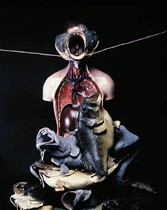 The conference’s Honored Educator Robert Fichter bears witness to environmental destruction and militarism through his fantastical invented characters, which dominate his mixed media work. Using drawing, painting, printmaking and photography, Fichter couches his politics with dark humor. The highlight of the presentation was his 1960s short film entitled, “Whatever Happened to Edward Weston?” This kooky and surreal black-and-white experimental film portrays renowned modernist photographer Weston as ‘Blacaman’, a Hindu animal hypnotist (right, Robert Fichter’s “Medical Analysis,” 1982, Cibachrome).
The conference’s Honored Educator Robert Fichter bears witness to environmental destruction and militarism through his fantastical invented characters, which dominate his mixed media work. Using drawing, painting, printmaking and photography, Fichter couches his politics with dark humor. The highlight of the presentation was his 1960s short film entitled, “Whatever Happened to Edward Weston?” This kooky and surreal black-and-white experimental film portrays renowned modernist photographer Weston as ‘Blacaman’, a Hindu animal hypnotist (right, Robert Fichter’s “Medical Analysis,” 1982, Cibachrome).
Samuel Yates bears witness to the absurdity of bureaucratic social structures in government. In his performative sculptural works, Yates Yates explores how objects lose their normal meaning, transformed by the ludicrous jumble of permitting and contract laws. In one project, Yates shredded an MG car at a recycling center that divided the parts by material. Yates categorized each car part by weight, labeling, bagging and placing the parts in vertically stacked file cabinets. The resulting sculpture is listed in the Guinness Book of World Records as the tallest file cabinet.
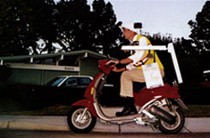 Currently, Yates is working on a public art commission entitled, “The Color of Palo Alto,” in which he digitally photographs every property in the city in alphabetical order, finding the average color of the city. To begin work on the project, Yates spent a couple of years with various city government board and councils to receive permission and permits for his project. Exploring the nature of the artist as public servant, Yates’ project is already in use by various city departments including zoning and planning boards (left, Samuel Yates on his bike in Palo Alto, 2005).
Currently, Yates is working on a public art commission entitled, “The Color of Palo Alto,” in which he digitally photographs every property in the city in alphabetical order, finding the average color of the city. To begin work on the project, Yates spent a couple of years with various city government board and councils to receive permission and permits for his project. Exploring the nature of the artist as public servant, Yates’ project is already in use by various city departments including zoning and planning boards (left, Samuel Yates on his bike in Palo Alto, 2005).For a regional conference, this exceeded all expectations. The presenters began the dialogue with their work and challenged us to question our roles as artists in this age of power, armed conflict, globalism and technology.
–Videographer Colette Copeland teaches at University of the Arts and the University of Pennsylvania









